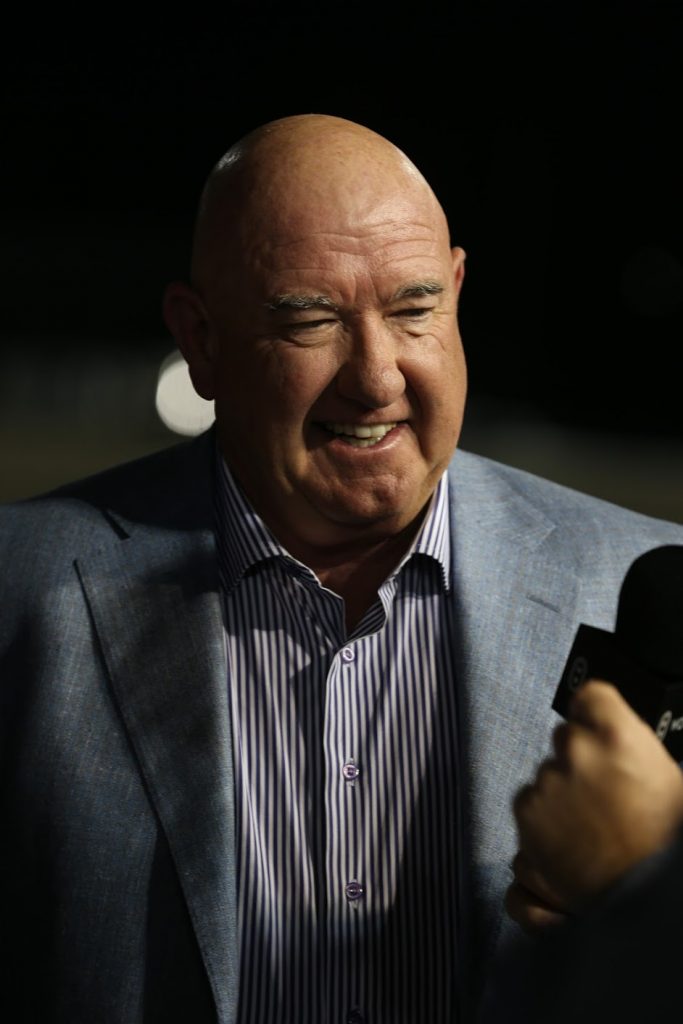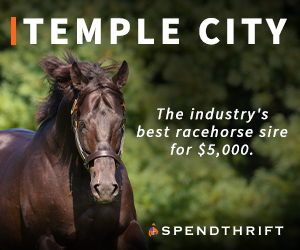
By Chris Lomon
TORONTO, October 2, 2020 – Although John Fielding remains modest in speaking of his time on the board at Woodbine Entertainment Group (WEG), the contributions he made are quite the opposite.
One of horse racing’s most passionate supporters, Fielding, who owned his first Standardbred at the age of 16, recently announced he was stepping down from the board he served on for 16 years.
“I think any good board needs fresh ideas, fresh faces and younger ideas,” said Fielding, who retired as Director and Chair of the Standardbred Racing Committee. “I thought it was a good time to give someone else a kick at the can.”
Throughout his time on the WEG board, Fielding, one of the highest profile and successful names in harness racing, a two-time owner of the year, whose star Standardbred pupils include Father Patrick and 2018 Hambletonian Oaks winner, $2.2 million earner, Manchego, worked in concert with other board members to navigate the industry through difficult periods.
Most notable of all, Fielding recalled the 2012 cancellation of SARP, the Slots At Racetrack Program, that plunged horse racing in Ontario into peril.
While plenty of questions surrounded the future of the sport, Fielding felt confident the sport wouldn’t simply survive, but would one day thrive.
Coming up with the right answers was hardly an easy task, but the board, Fielding included, worked diligently to find them.
“After the SARP cancellation, making our way through that was a real challenge,” noted Fielding. “It was a challenging time for the horsepeople and everyone connected to the industry because we were all caught so off-guard. The rebuilding to healthiness I think has been a great feat for everyone on the board and for Woodbine, and its management team as a whole. It’s been a long road, but I think we’re really on the right path now. I thought we’d get to where we are today. There was enough clout in the industry and I thought the industry was strong enough to come together and do the right thing to get to the place where we’re at now.”
Jim Lawson, CEO of WEG, (who shared a story about how his family and the Fieldings share a connection dating back to WWI, see below) has high praise for Fielding’s many contributions on the WEG board, and to racing itself.
“From my perspective, at the end of the day, what Woodbine is all about is horse racing,” said Lawson, chair of the Thoroughbred Racing Committee on the WEG Board, and a member of the Standardbred Racing Committee. “When you have strong, passionate horsepeople on the board, it really helps with the mandate because it brings back into focus that horse racing is what we are. That can manifest itself in a couple of ways. All of the opportunities and different things we look at – we have to be mindful that it’s horse racing owners, breeders, and wagering customers that we need to serve. We have this wonderful set of real estate assets and other things we can be pursuing, but at the end of the day, when you have a strong horseperson on your board – as a CEO, I certainly didn’t need the reminder – it sure helps when you have people like John who are focused on racing.”
Lawson also noted Fielding’s ability to approach issues in racing with a fair and open mind, someone capable of seeing varying perspectives through a unique lens.
“John wore both hats, being a Standardbred owner and being on the board,” started Lawson. “He could be objective about things. He could give an objective answer wearing both hats. I truly appreciate that. I’ve come out of a Thoroughbred background – everyone knows that – and I always remind myself to wear both hats. John naturally wears both hats, which is a great foundation for me looking at things. One critical move was moving the Standardbreds out to Mohawk permanently. Everyone looked at me a little cross-eyed when I first mentioned it. Immediately the question came up, ‘So, Jim, you’re doing all of this real estate development at Woodbine and you’re ultimately going to generate proceeds. Hopefully, as CEO, you’re not going to produce all these proceeds for Thoroughbreds, are you?’ I don’t think that way. Anything we make on real estate is to the benefit of our business, which means both breeds. Having John there as a person who could easily and naturally wear two hats was important for me, someone that I could consult with. Occasionally, as you might expect, conflicts come up between different races, different nights, events, expenditures… it was good to have John as a sounding board. He was kind of my go-to guy when I needed consultation. He knew horse racing. He wore those two hats well. That was important.”
For Fielding, it was important to play his part in seeing horse racing thrive in Ontario.
It was a hallmark of his time on the board, and it remains one to this day.
His personal horse racing road to success was forged well before his time on the WEG board.
Growing up in Toronto, he rode the streetcar with his brother to Greenwood Raceway where their passion for the sport first began. Introduced to harness racing by his father, Fielding rose up the ranks to become one of its most celebrated owners. He has over 20 Breeders’ Crown titles to his name, and has also enjoyed success with Thoroughbreds. In the late ‘90s, Fielding met Standardbred and Thoroughbred breeder Fred Hertrich at a Standardbred sale at Woodbine. They recorded their first win as breeders in the 2017 Thoroughbred World Championships when Rushing Fall won the GI Breeders’ Cup Juvenile Fillies Turf.
Just the type of person – and horseperson – tailor-made to sit on the WEG board.
“John led the Standardbred Committee for years and he did that in a very balanced way,” said Lawson. “Even as chair of the committee, he knew he had a larger fiduciary duty. I think that stands out for me, the manner in which he led that Standardbred Committee. He never forgot that he had a larger responsibility to the corporation, and I admired him for that.
“Secondly, much like [accomplished Thoroughbred trainer] Mark Casse – I’ll throw that out there – they’re great ambassadors for the Woodbine brand, internationally, and in particular, North America. John is very much in the mix, given the level of his investment in both breeds. Thirdly, I’m reminded of the recent Mohawk Million. He stepped up and bought a slot himself, but he was, in no small way, in that ambassador role, letting people know about the race. He encouraged people to buy slots. We need to thank him for his involvement in the Mohawk Million, too.”
Fielding, founder of Array Marketing, a leading global provider of retail merchandising solutions, is thankful himself, appreciative of his time on the board and for the friendships he made because of that role.
“I’ve met some wonderful, wonderful people and made some fantastic friendships that will last the rest of my life. I’m proud of what we’ve accomplished thus far. I’m proud to have been associated with it, and I’m proud of both breeds. We still have a ways to go, but we’re on real level footing now. It’s been a pleasure working with the different chairs I have, including Jim Lawson, and the different management teams. I think the management team we have now is the strongest I’ve ever seen it. It’s a great team and I think we’re in good hands.”
While he’ll be dedicating more time to his business interests and family, one thing that won’t change is Fielding’s enduring bond with horse racing.
“I’m so busy with my business interests that you have to try juggle your life around this business. I’m involved in horse racing quite extensively, in both breeds, but that, in addition to all of the other business interests I have, you kind of run short of time when you want family time, and other things. You have to simplify things the older you get.
“But this sport, it gets into your blood and it got into my blood at a very young age. I always dreamt of being involved in the industry, both Thoroughbreds and Standardbreds. I was a huge fan of E.P. Taylor, and I think the board and everyone involved in horse racing could always look at him as the key figure, the one who bought all the land where we are at Woodbine today. He had the vision. The job of the board is to be the custodian of that property and those wishes. And I think we’ve done a very good of that. Horse racing is alive and well.”
Another big reason why Fielding believes the board, and industry, is in good hands.
“As we move into the next phase of trying to make horse racing fully self-sustainable, I think we’re doing all the right moves. I think the future is going to be very bright for horse racing in Ontario.”
Thanks, in no small part, to the efforts of John Fielding.
*
From Jim Lawson:
“My great uncle, who my dad [Mel] was named after, went to war in World War I, and died on the battlefield right near the end of the war. Ultimately, what was recovered was his diary, and then after that, some letters, when my dad did some family tree searching. It turned out that my great uncle had been corresponding and had intended to marry a woman named Grace Fielding. That wasn’t her maiden name, but that was John’s grandmother. When my dad found out that his great uncle who he was named after – my dad and I visited his gravesite in France and followed his battle route form his diary – he tracked down Grace Fielding who was in a nursing home in Hagersville [ON]. Starting around 1985, my dad started visiting Grace and talking with her. She had saved those letters from my great uncle from Word War I in the battlefields.
Early on, the Fielding family became aware of this man – who was in the horse racing business – that was visiting their mother and grandmother. Around that time, John was becoming a big investor in horse racing. When my dad had some good horses like Eternal Search and Let’s Go Blue, John’s grandmother was cutting out clippings from the newspaper and sending them to John. We have this family connection going back to then.
Going back 35-40 years, I found out that John was a huge fan of racing through this unusual connection between the Lawsons and the Fieldings, a story that dates back to World War I. I knew about John and John knew my dad. He approached my dad back in the 1980s.
I was asked to join the board of Woodbine and John was already on the board. I had heard about him, and when I walked into the first board meeting, he gave me a hug. He said, ‘I know you! We should have been relatives.’ Then we both recounted the stories of my great uncle and his grandmother.”



